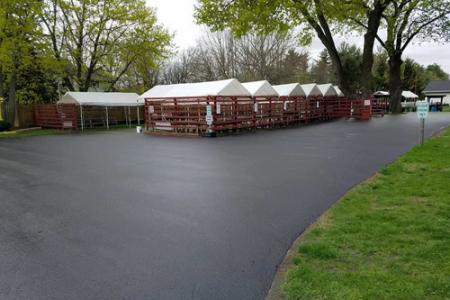Sealcoating
Commercial Sealcoating
The moment asphalt is laid it begins to deteriorate. By using Smith's professional asphalt maintenance services, customers can significantly increase the life of existing parking lot asphalt through proper crack filling and sealcoating. With the skyrocketing costs of asphalt raw materials, preventative maintenance is essential.

Sealcoating with Smith's Paving and Sealcoating shields asphalt paving from the sun's ultraviolet rays, which can deteriorate the binder and expose the aggregate. Parking lot sealcoating also prevents water and ice from getting into and under the pavement and causing it to crumble. The more solids (asphalt, coal tar, polymers, etc.) in the formula, the better the sealer quality and the more expensive it will be. You'll get what you pay for, and you get more solids in better sealers.
Smith's Paving and Sealcoating has a selection of parking lot sealcoating products to choose from depending on our customers’ preferences. We offer NEYRA Pave Shield and Copeland Action Paver sealers.
NEYRA Pave Shield Advantages
- Sand Based Slurry for Slip Resistance
- Environmentally Friendly and User Friendly
- Extends the Life of Your Asphalt
Copeland Action Paver Advantages
- Sand Slurry for Slip resistance
- Protection from Oils and Gases
- Coal Tar Additives exceptional
- Extends the Life of Your Asphalt
According to Sealer Manufacturers and Engineers at the Asphalt Institute, new asphalt should cure for about 4-12 months before sealing. Then, use a plain sealer. Beware of consumer-grade driveway sealers. These are usually an asphalt-based, paint-like coating.
It's important to fill cracks and seal expansion joints between asphalt and other surfaces such as concrete aprons or curbs. This keeps water out and prevents erosion of the paving base. Filled seal coating materials will handle cracks up to 1/8" wide. Hot-applied crack sealer is best for filling cracks from 1/8" to 3/4" wide. The crack sealer we use at Smith's is a hot-applied, polymer-based material. Using a hot sealer is far superior to a cold-pour sealer. Cold-pour sealers, although marginally less expensive, do not adhere as well.
The crack is first cleaned using a wire brush and a high pressure stream of air to blow out dust and debris. Then, the crack sealer is either injected into the crack with a pressurized wand or poured in at a temperature of roughly 300 degrees Fahrenheit. This extreme heat causes the sides of the asphalt in the crack to melt and form a much stronger bond with the crack sealer upon cooling. Also, because of its high melting point, it will not track or pick up with traffic. Due to its high elasticity, hot crack sealer has the ability to expand and contract with the pavement as temperature changes.
Smith's Paving and Sealcoating recommends staying off the newly sealed parking lot for at least 24 hours, and preferably 48 hours, to allow it to dry before driving on it. This prevents tire tread marks that occur from rotating the tires on the lot. Block off your parking lot and stop foot traffic to prevent indoor tracking that can stain floors.
We choose a weather window that gives us temperatures above 50 degrees, no rain in sight and no or low wind. Should winds pick up we will squeegee, rather than spray the sealcoat to avoid over-spray on nearby buildings and vehicles. In commercial buildings schedule delivery, landscape and fire sprinkler people after 48 hours.
Unprotected black top remains porous, dries out, becomes rough, and loses its life rapidly.
